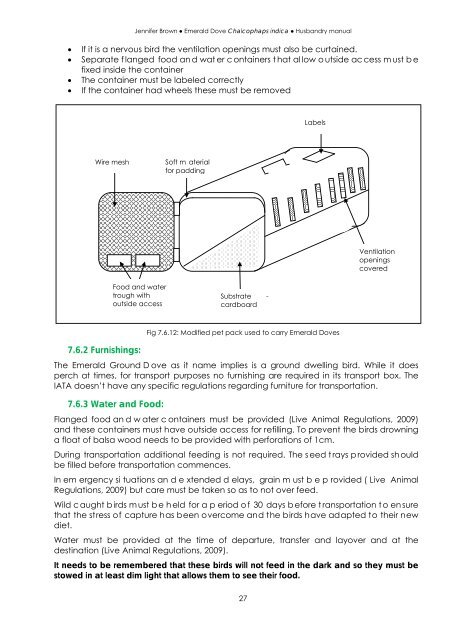Emerald Dove Husbandry Manual - Nswfmpa.org
Emerald Dove Husbandry Manual - Nswfmpa.org
Emerald Dove Husbandry Manual - Nswfmpa.org
Create successful ePaper yourself
Turn your PDF publications into a flip-book with our unique Google optimized e-Paper software.
Jennifer Brown ● <strong>Emerald</strong> <strong>Dove</strong> Chalcophaps indica ● <strong>Husbandry</strong> manual<br />
• If it is a nervous bird the ventilation openings must also be curtained.<br />
• Separate f langed food an d wat er c ontainers t hat al low o utside ac cess m ust b e<br />
fixed inside the container<br />
• The container must be labeled correctly<br />
• If the container had wheels these must be removed<br />
Labels<br />
Wire mesh<br />
Soft m aterial<br />
for padding<br />
Ventilation<br />
openings<br />
covered<br />
Food and water<br />
trough with<br />
outside access<br />
Substrate -<br />
cardboard<br />
7.6.2 Furnishings:<br />
Fig 7.6.12: Modified pet pack used to carry <strong>Emerald</strong> <strong>Dove</strong>s<br />
The <strong>Emerald</strong> Ground D ove as it name implies is a ground dwelling bird. While it does<br />
perch at times, for transport purposes no furnishing are required in its transport box. The<br />
IATA doesn’t have any specific regulations regarding furniture for transportation.<br />
7.6.3 Water and Food:<br />
Flanged food an d w ater c ontainers must be provided (Live Animal Regulations, 2009)<br />
and these containers must have outside access for refilling. To prevent the birds drowning<br />
a float of balsa wood needs to be provided with perforations of 1cm.<br />
During transportation additional feeding is not required. The s eed t rays p rovided sh ould<br />
be filled before transportation commences.<br />
In em ergency si tuations an d e xtended d elays, grain m ust b e p rovided ( Live Animal<br />
Regulations, 2009) but care must be taken so as to not over feed.<br />
Wild c aught b irds m ust b e h eld for a p eriod o f 30 days b efore t ransportation t o en sure<br />
that the stress of capture has been overcome and the birds have adapted to their new<br />
diet.<br />
Water must be provided at the time of departure, transfer and layover and at the<br />
destination (Live Animal Regulations, 2009).<br />
It needs to be remembered that these birds will not feed in the dark and so they must be<br />
stowed in at least dim light that allows them to see their food.<br />
27

















